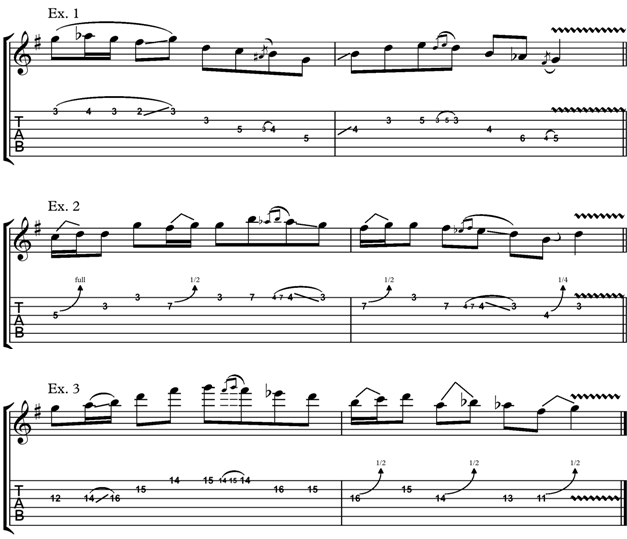Spice It Up: Blues and Eastern Fusion, Part 2

The last time we discussed the search for exotic sounds — and how to blend them with more-familiar blues — we explored the flavors of Hungary.
This time, we're going to sample some Egyptian spices.
While this might seem like a long flight with no connections, there’s more here than meets the eye.
Egyptian Pulp Fiction
In my previous column (See the link above), I used the Hungarian minor scale in A (A B C D# E F G#). I used it in a bluesy way, and someone commented that it sounded "Arabic." Well, there’s a lot of truth in that; if we start this scale from its 5th degree, we’ll get the “Arabic scale”: E F G# A B C D#, which is also known as the minor gypsy scale, Byzantine scale and double harmonic major scale.
You’ll probably recognize the scale if you’ll listen to Dick Dale’s version of "Misirlou," which was was in Quentin Tarantino’s Pulp Fiction. It’s worth mentioning that this piece was originally composed as a Greek folk song about an Egyptian girl.
“Arabic scale” is a misleading term, as there is a whole different system of Arabic music “scales” that are called maqamat (The singular form is "maqam") and are used more as a technique of melody improvisation rather than in a theoretical way. The closest maqam with the same intervals would be Shad Araban in the key of G (G Ab B C D Eb F#), which I'm going to fuse with blues now.
The most interesting thing about this scale is the half-step neighbors G has on both sides: F# and Ab. This idea on all its variations can be heard in many genres, from Django Reinhardt’s gypsy jazz solos to war leitmotifs in film music. But this is my take on how they can be used with blues:

In these three examples, I used elements from known blues licks in minor and major pentatonic blues scales and added the tanginess of these exotic notes. I find this combination fascinating because it allows the expansion of simple phrases into longer interesting melodies without over-complicating it.
The “Arabic” effect here is due to the famous augmented second interval that appears twice in this scale (Ab-B, Eb-F#) — hence the name “double harmonic." You can use the following backing track to practice this multicultural marriage:
Tips to Remember
There are two good ways to remember the Arabic scale. First, take a triad of the chord G (G B D) add the triad of the minor 2nd chord Ab (Ab C Eb) and finish with the major 7th (F#). Have a look at the first bar for an illustration:

The second bar shows the Cm Hungarian scale (C D Eb F# G Ab B), which is as aforesaid the “cousin” of the Arabic scale. This position also can work well with the 4th degree (Cm) in 12-bar blues and for which you may use licks from the previous lesson by transposing them accordingly.
Watch this space for the next column in this series, which will blend blues with Far Eastern sounds.
Udi Glaser is a guitarist, guitar teacher, composer, producer and journalist. He has been playing all types of guitars and styles for more than 22 years and has been teaching them for more than 10 years. He holds a bachelor's degree in musicology and philosophy and attained a sound-engineering diploma and an Orchestrating Producing for Film and Games certificate, for which he received a scholarship in the name of Jeff Beck. Visit his website and follow his Facebook page or Twitter feed.
Get The Pick Newsletter
All the latest guitar news, interviews, lessons, reviews, deals and more, direct to your inbox!
“There are so many sounds to be discovered when you get away from using a pick”: Jared James Nichols shows you how to add “snap, crackle and pop” to your playing with banjo rolls and string snaps
Don't let chord inversions bamboozle you. It's simply the case of shuffling the notes around







![Joe Bonamassa [left] wears a deep blue suit and polka-dotted shirt and plays his green refin Strat; the late Irish blues legend Rory Gallagher [right] screams and inflicts some punishment on his heavily worn number one Stratocaster.](https://cdn.mos.cms.futurecdn.net/cw28h7UBcTVfTLs7p7eiLe.jpg)


